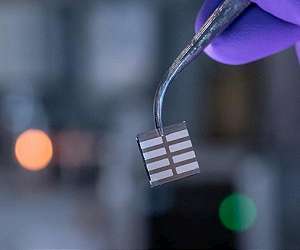A do-it-yourself device that started life as a hobby and took off during COVID-19 could help to unlock the next generation of solar energy, including advanced technology for space missions.
Dr Jamie Laird, a Research Fellow at the ARC Centre of Excellence in Exciton Science and the University of Melbourne, has invented a new machine for testing the defects in perovskite solar cells, the first of its kind anywhere in the world.
Perovskite solar cells can match silicon for efficiency, are cheaper to manufacture and more flexible, but they haven’t become commercially viable yet, because they’re still too unstable when exposed to heat, light, moisture and oxygen.
That’s where Jamie’s device comes in. A combination of a microscope and a special laser, it produces pictures and maps of the defects within solar cells and tells scientists where the cells are losing power or efficiency over time and use. It also provides data to indicate why.
An example of micro-spectroscopy, the innovative technique started life as a personal project for Jamie, and was originally intended to analyse minerals.
When he joined Exciton Science, Jamie realised his gadget would be a perfect tool to help colleagues – and other leading solar cell researchers around the world – to better understand the frustrating issues that have kept perovskites from fulfilling their exciting promise.
“The basis of the technique is microscopy but merging it with frequency analysis,” Jamie said.
“We use a laser beam and we focus to a spot and scan across the device to measure the quality of the solar cell.
“This new method allows us to do imaging analysis of whole or complete solar cells and look at how they perform, how they change with time and aging, and how good a solar cell they are.”
In addition to partners at Monash University, a team from Oxford University is already sending samples of cutting-edge prototypes to be tested by Jamie’s homemade machine.
And members of the University of Sydney working on experimental solar cells for satellites and other space vehicles are also on the waiting list to collaborate.
“You can’t have a solar cell that decomposes quickly when it’s meant to last 20 years in the field,” Jamie said.
“This is a missing link in the repertoire of techniques we have to throw at that problem.”
Research Report:Intensity Modulated Photocurrent Microspectrosopy for Next Generation Photovoltaics
Related Links
ARC Centre of Excellence in Exciton Science
All About Solar Energy at SolarDaily.com
|
We need your help. The SpaceDaily news network continues to grow but revenues have never been harder to maintain. With the rise of Ad Blockers, and Facebook – our traditional revenue sources via quality network advertising continues to decline. And unlike so many other news sites, we don’t have a paywall – with those annoying usernames and passwords. Our news coverage takes time and effort to publish 365 days a year. If you find our news sites informative and useful then please consider becoming a regular supporter or for now make a one off contribution. |
||
|
SpaceDaily Contributor $5 Billed Once credit card or paypal |
SpaceDaily Monthly Supporter $5 Billed Monthly paypal only |
|

![]()
Nontoxic material found to be ultra-strong solar energy harvester
London, UK (SPX) Aug 29, 2022
Solar cells are vital for the green energy transition. They can be used not only on rooftops and solar farms but also for powering autonomous vehicles, such as planes and satellites. However, photovoltaic solar cells are currently heavy and bulky, making them difficult to transport to remote locations off-grid, where they are much needed.
In a collaboration led by Imperial College London, alongside researchers from Cambridge, UCL, Oxford, Helmholtz-Zentrum Berlin in Germany, and others, researcher … read more
